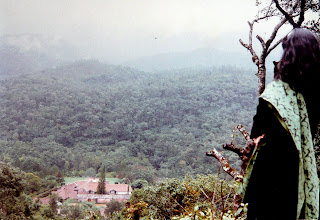Princely State of Salumber and a unique vintage photograph
I happened to come across a rare and old cabinet size photograph of Rawat Jodh Singh II of Salumber. Majestic in appearance and with an apparent disfiguration of his right eye, he aroused my curiosity about himself and Salumber, an erstwhile princely state of India.
Rawat Jodh Singh II of Salumber was born in 1833 in Bambora and reigned Salumber between 1866 and 1901. He was the adopted son of Rawat Kesri Singh II of Salumber. A rubber stamp on the back of this vintage cabinet photo shows that he was photographed by Mohan Lall of Oodeypoor.
Salumber was under the princely state of Udaipur and was the estate of Kunwar Khandal Singh. In 1901, it had a population of over 31000 and comprised of 237 villages. The ruler bore the title of 'Rawat', and held first rank amongst the nobles of Mewar. He was the first of the sixteen Umraos or senior feudal barons who had the privilege to wait upon the Maharajah of Udaipur. Salumber later became the capital of the Chundawat clan of the Sisodiya dynasty. Today, Salumber is a major town located 70 km south of Udaipur, Rajasthan. It is just 20 km away from the famous Jaisamand Lake and has the Maharana Pratap airport serving it.
Brief history:
In the dawn of the fifteenth century prince Chunda Sisodiya ,heir apparent of Mewar and the son of Maharana Lakha (1421-1433), renounced his claim to the throne in favour of his younger brother, Mokal, under very interesting circumstances ,but continued to serve the house of Mewar with utmost loyalty throughout his life. The Maharana was pleased with Chunda's commitment and loyalty and authorised the Rawats of Salumber to sign all important documents of State on behalf of the Maharana.
During this era, along with the Ranas of Mewar, the Rathors of Marwar were powerful chieftains. As it happens in India, alliance by marriage between the powerful clans was a tool to strengthen the relationships and to extend the sway over territories.
The heir apparent of Marwar was prince Ranmal and he went to the then Sisodiya capital of Chittor offering the hand of Hansabai, the beautiful Rathor princess to Prince Chunda. Incidentally, Chunda was not present in the palace and his old father Rana Lakha had received the guests when they arrived. The old Rana joked if the princess was a gift to him to which the short-tempered Ranmal nodded. Not to displease the guest, the Rana kept silence. On his return, Prince Chunda decided that a gift intended for his father was best left to him and thus his father married Hansabai.
Ranmal reportedly put forth a condition that Chunda should renounce his claim to the throne in favour of the son born out of the wedlock of Hansabai and Rana Lakha. Chunda, like a modern day Bhishma, took the royal oath and thus Mokal, the son of Hansabai succeeded to the Mewar throne on the death of Lakha in AD 1421.
Regretfully, Maharana Mokal was murdered in 1433. Ranmal avenged the murder and took over as the regent to Maharana Mokal's infant son, Kumbha. Ranmal gradually took control of the administration and wanted to install his lover Bharmali, a palace maid, the Queen of Mewar. Mokal’s widow brought Chunda who sacrificed much for Mewar and they plotted the murder of Ranmal dazzling with wine and women by using the wiles of Bharmali.
Chunda drove of Jodha, Ranmal's young son and captured the Rathor capital which was left to be ruled by his two sons. Jodha returned after twelve years and took revenge by killing both the sons inflicting defeat on the Sisodiyas. Thereafter comparative peace prevailed between Marwar and Mewar for the next three centuries.
Jodha went off to found a new capital in Jodhpur in 1459 and Chunda founded the "Chundawat" dynasty.
(Some information on Mewar history has been collected from http://www.deogarhmahal.com/h_history1.htm)
Dubai, 9th February 2009.




Comments
Kind regards,
Once again, I thank you for your comments which reflect much warmth.
kind regards,